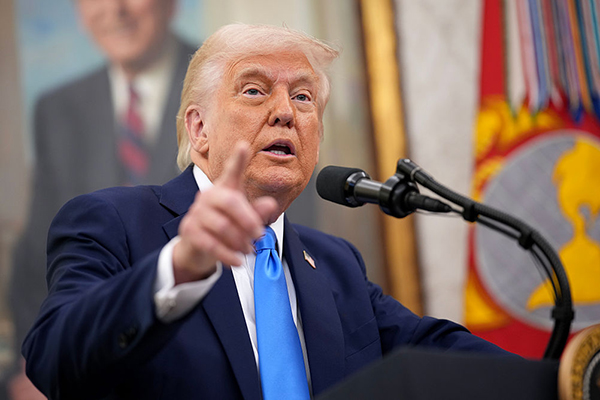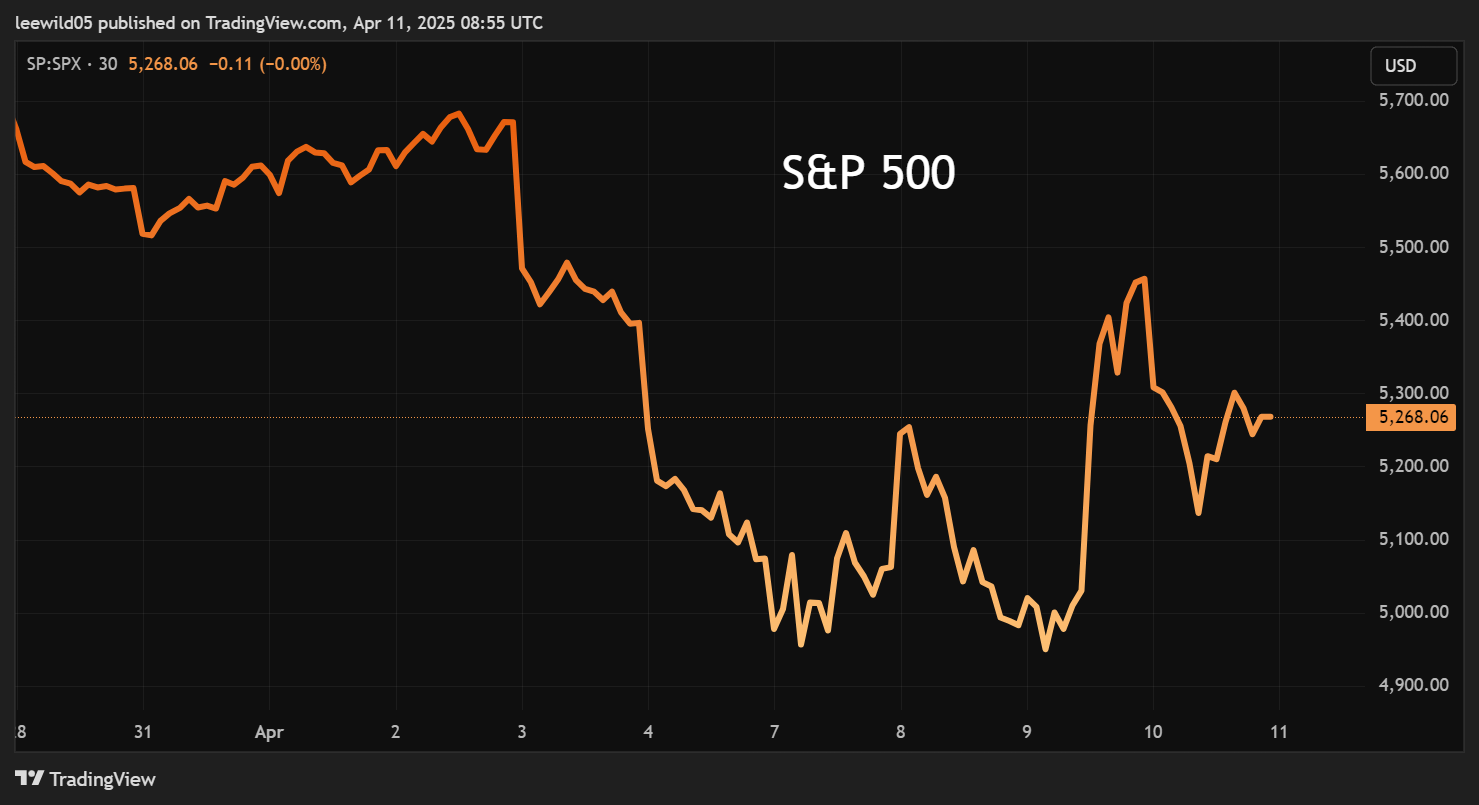Stockwatch: let’s see how tariff chaos affects company profits
As American companies start to issue quarterly results, analyst Edmond Jackson assesses the ever-changing landscape and looks at how investors might choose to act.
11th April 2025 11:19
by Edmond Jackson from interactive investor

Credit: Andrew Harnik/Getty Images.
“Trump blinked first” in a “tariffs climbdown” last Wednesday, the S&P 500 surged nearly 10% and other global indices managing 6-8% rebounds on Thursday.
Mind how with headline tariffs between the US and China at 145% and 125% respectively, 25% on vehicles/parts into the US, with Mexico/Canada unaffected by a 90-day pause, and a 10% duty from the US on all other countries, the average tariff looks nearer 25%.
- Invest with ii: US Earnings Season | Buying US Shares in UK ISA | Cashback Offers
Some economists proclaim this is greater than under the 1930 Smoot-Hawley Act, which contributed to the Great Depression after US imports plunged 66%, exports by 61% and gross domestic product (GDP) nearly halved by 1933. From 1929 to 1934, world trade contracted by two-thirds.
The Smoot-Hawley situation was rather complex, where the dutiable US tariff rate was 59% at the 1932 peak versus 62% in 1830. But in the early 1930s, 63% of all imports were not taxed, thus reducing the effect of an average tariff rate on dutiable imports that hiked from 40% in 1929 to 59% in 1932.
Historical complications are a bit tricky, but we know for certain that the disruptive effect on business is going to ripple out, initially in company trading updates and outlook statements, with the US earnings season due to kick off in earnest soon.
While some investors say last Wednesday/Thursday affirms a “buy the drop” approach, and that markets always resume their long-term uptrend, I say we have yet to see how this chaos is going to affect earnings.
- ‘Cockroach shares’ the pros are backing to survive market turmoil
- Anatomy of a stock market crash and playbook for the recovery
Comparisons are also made with the ill-fated Liz Truss government, but the Republican Party does not have a 1922 Committee like the Conservatives here, which ruthlessly removed Thatcher, Johnson and Truss when things started to go wrong. Nor does the US Congress appear to have any mechanism or will to challenge an over-concentration of power on trade policy with the president. The only check is talk of legal challenges.
Business is currently suffering daily wrecking ball swings such as Trump promising on Wednesday “a major tariff on pharmaceuticals at a level you haven’t really seen before”. Last night, he threatened Mexico with more tariffs and even sanctions for weak compliance with an 81-year-old treaty to supply water to Texas farmers.
A silver lining courtesy of bond vigilantes
No one in Trump’s administration seems prepared to challenge the president, unlike in his first term. Instead, it was soaring yields on $36 trillion (£27 trillion) of US government debt, raising its service costs that caused him to pivot.
Similarly, as with Prime Minister Truss in September 2022, the “bond vigilantes” held Trump to account. The key question arising being where such a trigger point might lie on an ongoing basis? How much damage is required to business? While the US economy has serially defied its doubters pretty much since 2010 – with on/off talk of recession – this time the tariff dilemma, especially with China, looks very hard to dodge.
It was interesting how last Tuesday there was nowhere to hide in the flight from risk assets. This recalled Black Monday in 1987 and various days in the 2008 crisis when even classic defensive assets such as the dollar, US Treasuries and gold, all fell.
As I mentioned last Tuesday, a sudden 10% plunge in market indices was technically overdone in the very short term, creating scope for a relief rally. The risk premium has risen on equities, however, so volatile months lie ahead.

Past performance is not a guide to future performance.
Keep investing regular sums throughout the chaos?
You could say it is precisely when everything is so uncertain that long-term value is offered in the shares of businesses with strong competitive position and track record, including dividends. Fretting over the impact to earnings is to miss an opportunity, at least to take some action. Markets are inherently unpredictable.
I think it hinges on whether a recession does materialise – first in the US, then exported globally. This tariffs burden on US/China trade is colossal, requiring a radical shift in sourcing of US imports and baking in higher prices for US consumers and intermediaries.
President Xi Jinping cannot capitulate as it would finish him domestically. There is a visceral sense from centuries past, of foreign powers humiliating China, which explains its firm resistance to Trump’s antics. His belittling China with “peasants” remarks, ingrains resentment.
A China Daily editorial published on Wednesday said: “Caving in to the US pressure is out of the question for Beijing...it is not that China does not understand what the unprecedented high tariffs mean for its exports and the economy in general”.
Since Trump’s first trade war with China in 2018, it has boosted trade with other countries. From 2018 to 2020, Brazil’s soya bean exports to China leapt by nearly a half, while US exports declined over a third. While China remains the largest market for US agriculture, it is falling.
Yet the Chinese economy is certainly not tariff-proof, the Communist Party yet to figure out how to improve domestic demand.
- Six things to know about volatile markets and your pension
- Sign up to our free newsletter for investment ideas, latest news and award-winning analysis
On Wednesday, the World Trade Organisation (WTO) cited an 80% potential hit to US-China goods trade, impacting the global economy. The US and China together account for 3% of world trade, so take your view on how significant that is generally. The WTO also speculated on the global economy breaking into two blocs, one centred around the US and the other China.
At very least the drag on business and investment from higher prices implies stagflation; time will tell whether recession.
If you follow value investing principles, you therefore seek a reasonable sense of the dynamics. Only in the full impact of a recession might you relax such a need. Taking a view, market price looks so compelling and the business’s overall calibre strong, that risk/reward on the shares imply medium-term upside.
That is worth bearing in mind as a working principle, although I concede it does involve a sense of market timing given that equities generally fall ahead of a recession and start rising again amid poor earnings releases, as the market attempts to price in recovery.
My concern with chasing this current bounce is that the real opportunities potentially lie some months ahead. However, I would agree that Trump is unpredictable to an extent that it excuses an investor who steadily and patiently accumulates shares throughout the chaos – if that works for you.
Mind risk premium in UK small-cap especially
Some investors say that UK mid-cap and especially small-cap stocks are broadly unaffected by all this. Yet much US slowdown will be felt by the wider economy, and if a broad sense of risk-aversion takes hold, then UK small-cap ratings can fall generally, even if trading updates and results are quite resilient.
This partly relates to lack of liquidity, and also a sense that eventually a recession will punish most smaller companies hard. It is why small-caps tend to sell off on fears of a recession. We are not there yet but it is a factor to bear in mind for portfolio balance -take special care if your equities portfolio is small-cap-weighted.
The real verdict on Trump’s actions is not conveyed by this week’s market swings; more likely it will take half-year results issued from next September to give a true assessment.
Edmond Jackson is a freelance contributor and not a direct employee of interactive investor.
These articles are provided for information purposes only. Occasionally, an opinion about whether to buy or sell a specific investment may be provided by third parties. The content is not intended to be a personal recommendation to buy or sell any financial instrument or product, or to adopt any investment strategy as it is not provided based on an assessment of your investing knowledge and experience, your financial situation or your investment objectives. The value of your investments, and the income derived from them, may go down as well as up. You may not get back all the money that you invest. The investments referred to in this article may not be suitable for all investors, and if in doubt, an investor should seek advice from a qualified investment adviser.
Full performance can be found on the company or index summary page on the interactive investor website. Simply click on the company's or index name highlighted in the article.
Disclosure
We use a combination of fundamental and technical analysis in forming our view as to the valuation and prospects of an investment. Where relevant we have set out those particular matters we think are important in the above article, but further detail can be found here.
Please note that our article on this investment should not be considered to be a regular publication.
Details of all recommendations issued by ii during the previous 12-month period can be found here.
ii adheres to a strict code of conduct. Contributors may hold shares or have other interests in companies included in these portfolios, which could create a conflict of interests. Contributors intending to write about any financial instruments in which they have an interest are required to disclose such interest to ii and in the article itself. ii will at all times consider whether such interest impairs the objectivity of the recommendation.
In addition, individuals involved in the production of investment articles are subject to a personal account dealing restriction, which prevents them from placing a transaction in the specified instrument(s) for a period before and for five working days after such publication. This is to avoid personal interests conflicting with the interests of the recipients of those investment articles.